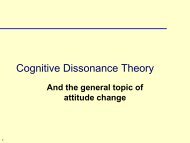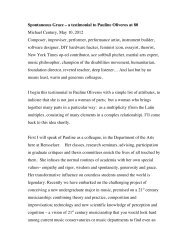Face Negotiation Theory
Face Negotiation Theory
Face Negotiation Theory
- No tags were found...
You also want an ePaper? Increase the reach of your titles
YUMPU automatically turns print PDFs into web optimized ePapers that Google loves.
<strong>Face</strong> <strong>Negotiation</strong> <strong>Theory</strong>• Based on the work of Stella Ting-Toomey.• Intercultural and ethnographic in nature.• Adapted from the “naïve psychology” concept of face,as in losing face, saving face, etc.
<strong>Face</strong>…• Is “a metaphor for the public image people display.”• Is from the very old idea in some Asian cultures of“face.”• Refers to the boundaries people have in theirrelationships with others.• Something that is maintained, lost or strengthened.• A projected image of one’s self and its claim to selfrespectin a relationship.• A pan-cultural phenomenon.• Operates according to rules that vary across cultures.
Aspects of <strong>Face</strong>• <strong>Face</strong> concerns the following:• <strong>Face</strong> concern – one’s interest in maintaining one’s faceor the face of others.• <strong>Face</strong> need – one’s desire to be associated or dissociatedwith others.• From politeness theory, <strong>Face</strong> involves two needs:• Positive <strong>Face</strong> – one’s desire to be liked and admired byothers.• Negative <strong>Face</strong> – one’s desire to be autonomous and freefrom others.
<strong>Face</strong>work• <strong>Face</strong>work refers to all the actions used to deal with theface wants and face needs of one’s self and of others.• It comes in three varieties:• Tact facework – the extent to which one personrespects the autonomy of another.• Solidarity facework – accepting another as a memberof an ingroup.• Approbation facework – emphasizing the positiveaspects of another while deemphasizing their negativeaspects.
Assumptions of the <strong>Theory</strong>• Certain acts (<strong>Face</strong> Threatening Acts, or FTAs) threatenone’s projected self-image (face).• Can be direct or indirect.• If an FTA looms…• <strong>Face</strong>-Saving – done beforehand to stave off loss of face• <strong>Face</strong>-Restoration – done afterwards as damage control, or asexcuse-making.
Individualism vs. Collectivism• These are:• Individualism – a cultural value that places emphasis onthe individual over the group.• Collectivism – a cultural value that places emphasis onthe group over the individual.• Cultures vary along this dimension, with…• USA as #1 in Individualism,• Some Asian and Central American countries as highlycollectivist.• (This may be confounded with issues of poverty.)
<strong>Face</strong> Management• Individualist cultures, not surprisingly, tend to engagein overt face management strategies that work topreserve one’s own face.• Self-assertion• Collectivist cultures have people more willing to adapttheir self-presentation images for the sake of thecollective.• Empathy
Styles of Conflict Management• Five Basic Styles:• Avoiding (AV) – staying away from disagreements• Obliging (OB) – satisfying the needs of others• Compromising (CO) – using give-and-take to achieve amiddle of the road resolution• Dominating (DO) – using influence or authority tomake decisions• Integrating (IN) – collaborating with others to findsolutions.• These vary culturally but also depend on immediateface needs and concerns.
Observed Styles• USA: more Dominating than most other places• Taiwan: primarily Integrating• China and Taiwan: significantly more Obliging• China: more Avoidance than most other cultures• China: more Compromising than most other cultures
Critique of <strong>Face</strong>-<strong>Negotiation</strong>• As an intercultural theory, it has a number ofchallenges, and is quite high level in its concerns.• Because it is based on ethnography, collecting data isarduous.• Heurism – Has been of considerable interest tointercultural researchers, who need all the theoreticalhelp they can get.
Critique of <strong>Face</strong>-<strong>Negotiation</strong>• Logical Consistency –• The cultural dimension of <strong>Face</strong> does not seem enough toexplain the observed behaviors.• Japan has more concern for self-face than predicted• US uses more compromise than predicted• (Often, observations that go this way signal the need touncover another variable.)• <strong>Theory</strong> is quite general, maybe too general.















![The Game Design Document [.pdf]](https://img.yumpu.com/30117124/1/190x245/the-game-design-document-pdf.jpg?quality=85)
